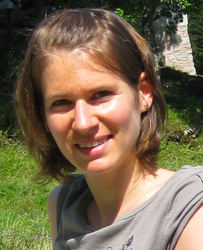 Doktorandin
DoktorandinAnnemarie Heiduk
e-Mail: annemarie.heiduk(at)uni-bayreuth.deFloral scents are most important signals in specialized pollination systems. However, little is known about the specific compounds responsible for pollinator attraction. In my research, I analyze floral scent in deceptive Ceropegia and closely related Brachystelma (Apocynaceae, Asclepiadoideae) by gas chromatography coupled to mass spectrometry (GC‐MS) to learn more about the compounds emitted by flowers of these plants. Furthermore, I have a focus on the identification of pollinators and the determination of the floral scent signals involved in pollinator attraction in both plant genera by using electrophysiological and behavioural analyses. Ceropegia evolved highly complex flowers, i.e. pitfall flowers, to temporarily trap fly pollinators. In contrast, Brachystelma, which was found in recent molecular phylogenies to be nested within Ceropegia, has non‐pitfall but typically open flowers. These plants are a good model system to study the factors favoring complex pitfall versus non‐pitfall flowers. The hypothesis is that the presence/absence of pitfall flowers has to do with different pollination systems: they evolved different strategies to exploit pollinators, which are attracted by floral scents. Pitfall flowers evolved independently in different plant lineages (e.g. Araceae, Aristolochiaceae, Apocynaceae-Asclepiadoideae, and Hydnoraceae), and the findings of my work may generally help to learn more about the selective forces resulting in the evolution of such complex flowers in angiosperms. Field work will be conducted in natural habitats of Ceropegia and Brachystelma species in South Africa:
- Pollinators will be identified by using a morphological as well as molecular approach.
- Floral scent of each species will be analyzed by dynamic headspace and gas‐chromatography coupled to mass spectrometry.
- Electrophysiological measurements will be used to identify specific scent compounds which can be detected by pollinators.
- Finally, the importance of natural and synthetic scent blends as well as single synthetic compounds for pollinator attraction will be determined in field bioassays.


